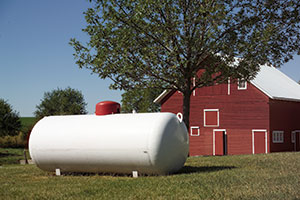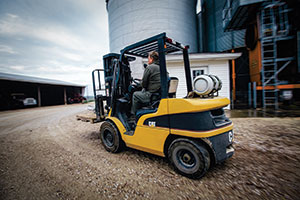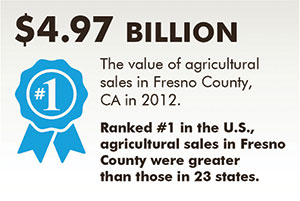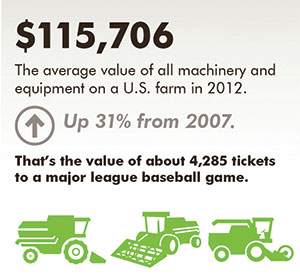Propane helps modern farmers fuel farm production
They spend billions, burn millions, and what we know about today’s farming operations can only benefit your business.

A propane retailer located in farm country has much to gain by reaching out to potential agricultural customers. Photo courtesy of the Propane Education & Research Council
Dennis Carnahan set out to tell agriculture’s story in a personal and accurate way.
Three to four generations ago, families had a closer connection to the farm. At the very least, dad or grandpa was a farmer. But today, as Carnahan explains, many people are removed from agriculture, clueless to the real world that exists on the farm.
“They might have this romanticized image of the 1940s farm, chickens in the pen and on the porch, a guy in big overalls and a straw hat. That’s the bygone era,” Carnahan says.
Since May 2011, Carnahan, 61, owner of Carnahan & Sons in Vincennes, Ind., has written a blog at carnahanandsons.com because, he believes, agriculture needs to tell its story better. His writing, about topics such as family life, farm days, harvest and planting, are also a way to update his extended family on happenings at the 4,200-acre corn, soybean and wheat farm in southern Indiana.
Carnahan’s look at today’s farm reveals a modern operation utilizing the valuable land of Middle America. The blog is a microcosm of today’s farmer – a look into their lives and businesses, at how their work has changed over the years, glimpses that could help the propane industry further tap into this market segment.
A professional bunch
Mark Leitman, director of business development and marketing for the Propane Education & Research Council (PERC), heaps praise on today’s farmer. He says the propane industry’s farming customers are professional businesses that pay their bills on time and utilize technology in their daily operation.
Farmers have been mapping fields with GPS for years, Leitman says. They use technology to treat specific parts of the land through a process called precision agriculture. The latest propane-fueled grain dryers feature advances that allow farmers to monitor operations online or from a smartphone or tablet.
Numbers from the recently released 2012 Census of Agriculture also help to support the claim that farms are trending toward technology. Farms with Internet access rose from 56.5 percent in 2007 to about 70 percent in 2012 – with 40 percent using a digital subscriber line (DSL) connection.
“The perception [of the farmer] has been slow to change,” Leitman says. “Maybe one farmer or customer does something in an old-fashioned way and it can paint a picture of the entire group unfairly sometimes.”
Energy intensive
A propane retailer located in farm country has much to gain by reaching out to potential agricultural customers, Leitman says.


Farmers spend billions of dollars each year on energy expenses. In fact, according to the Census of Agriculture, nearly 2 million farms reported spending $16.6 billion in a category called “gasoline, fuels, and oils,” which includes propane. That amount is up about $4 billion from 2007, but still accounts for only 5 percent of all production expenses.
“If nothing else, I love to keep reminding the propane industry that these farmers are spending billons of dollars on energy, so let’s not forget about them,” Leitman says. “Companies out there make money supporting the ag industry.”

Propane-fueled forklifts are prominent on the farm.
Photo courtesy of the Propane Education & Research Council
While farmers are spending billions of dollars on energy, they are burning millions of gallons of propane. The latest report from the American Petroleum Institute on sales of natural gas liquids shows the agricultural sector burned more than 800 million gallons of propane in 2012.
Iowa, North Carolina, Minnesota, California and Illinois were the top states for propane gallon sales to the agricultural market, accounting for 48 percent of the total volume.
“If you sell gas in my community, you have to sell to people who are using it,” says Dan Stangle, owner of Stangle Propane, which supplies Carnahan & Sons in Indiana. “If you want to sit around and wait on residential – which is great; we sell a lot of that, as well – you would just miss it.”
Propane is helping to fuel farm production that, in turn, is leading to record agricultural sales. U.S. producers sold about $395 billion worth of agricultural products in 2012 (with California, Iowa, Texas, Nebraska and Minnesota leading the way), though it cost them a record $329 billion in production expenses, according to the census.
The census, released by the U.S. Department of Agriculture every five years, also revealed 3.2 million farmers operating 2.1 million farms on 914.5 million acres of land in 2012. The number of farms decreased 4.3 percent from 2007, while the average farm size, at 434 acres, increased 3.8 percent. The average age of principal farm operators went up 1.2 years, to 58.3 years, continuing a 30-year trend of steady increase.

Farmers’ overall income (the first three lines above) has increased significantly from 2007, but so has their production expenses. What’s left is a near 24 percent bump in net income from five years earlier.
“While the aging nature of the farming population is a concern, we are hopeful that as we attract and retain the next generation of talent into rural America, this trend can also be reversed,” says Agriculture Secretary Tom Vilsack in a press release.
Feeling the heat
More than 865,000 farms in the United States use propane to run pumps and engines, heat buildings, and dry and process crops, according to PERC. But when it comes to propane use on the farm, heating applications are at the forefront.
A recent PERC survey of more than 200 large farmers and ranchers across nine states revealed that building heat and grain drying are the two most common applications for propane on the farm, at 47 percent and 35 percent, respectively. (Propane-fueled forklifts ranked third, at 12 percent.)
The survey also found that 46 percent of farmers and ranchers are prospects for conversion to propane for at least one application, and many of the top prospects are concentrated in the Midwest.

Five states – California, Iowa, Texas, Nebraska and Minnesota – generated more than one-third of all U.S. agricultural sales in 2012. Overall, agricultural sales were up nearly 33 percent in 2012 from the previous U.S. Department of Agriculture census (taken in 2007). Source: USDA NASS, 2012 Census of Agriculture.
Carnahan, the Indiana farmer who has been using propane for decades, is part of a new PERC case study on grain drying. Taking advantage of the council’s $5,000 Propane Farm Incentive Program, the family upgraded its propane-fueled dryer to a GSI X-Stream model in 2012 and says it has been getting 20 percent more in drying efficiency as well as added market flexibility and control over harvest timing.
The farm’s local equipment dealer, Midwest Ag Systems, was the key source of information on the dryer and incentive program, Carnahan says.
“A propane-fueled dryer is a demand-building tool because it locks the customer in for the life of the equipment – 20 years or more – and the profitability window for the farmer to operate the dryer widens,” Leitman says.
Depending on the drying season, Carnahan & Sons Inc. will burn 30,000 to 50,000 gallons of propane per year. It also uses propane for building heat and forklift fuel. It has an 18,000-gallon tank onsite for Stangle Propane to fill. The retail operation provides Carnahan with what he calls “the three Ps” of a propane supplier: price, promotion of service and personality.
Propane’s propensity to offer clean, portable, reliable heat is also a good fit for organic farms, whose sales grew over the last five years. Organic farmers reported $3.12 billion in sales in 2012, up from $1.7 billion in 2007, according to the census. These sales still only account for 0.8 percent of the total value of U.S. agricultural production.
“Organic farmers have to find solutions for weed and pest control that are non-chemical in nature,” Leitman says. “Propane is a great way to generate heat.”
USDA forecasts record-breaking corn yield
U.S. farmers remain on track to produce a record corn crop for the second straight year in 2014, according to U.S. Department of Agriculture (USDA) projections. The announcement impacts propane retailers who service farm customers for crop drying needs.
According to USDA, favorable early-season crop and weather conditions offset planting delays in May, and farmers are now expected to produce a record total corn crop of 13.9 billion bushels – slightly more than in 2013. USDA forecasts national average yields to be 6.5 bushels per acre higher than last year at 165.3 bushels per acre.
“While the crop outlook is robust, we approach it with cautious optimism,” says Martin Barbre, National Corn Growers Association president, in a press release. “All of us have seen conditions change quickly and a crop shift course in a few short weeks.”




















